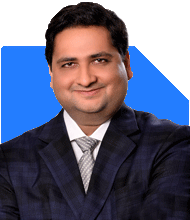Hardik Parikh | Answer |Ask -Follow
Tax, Mutual Fund Expert - Answered on Apr 11, 2023
He also holds an MBA degree from IIM-Indore.
Hardik, who began his career as an equity research analyst, founded his own advisory firm, Hardik Parikh Associates LLP, which provides a variety of financial services to clients.
He is committed to sharing his knowledge and helping others learn more about finance. He also speaks about valuation at different forums, such as study groups of the Western India Regional Council of Chartered Accountants.... more

Dear Sir, Iam 51 and I have been investing in diversified mutual funds since last 10 years and accumulated around Rs 1.28 Crores and continuing SIP's in following funds. Quant Large cap - Rs 9000, SBI Health care fund - Rs 5000, UTI Flexi cap fund - Rs 5000, Kotak Flexi cap fund - Rs 13000, Mirae asset hybrid equity fund - Rs 8000. I have also accumulated corpus of Rs 13 lakhs in NPS tier 1 and doing SIP of Rs 5000 every months. Further i have combine corpus of Rs 43 Lakhs in EPF and PPF accounts. I have invested Rs 4.72 Lakhs in 20 Year bonds of HUDCO, PFC tax free bonds in 2013 and receiving Rs 42000 every year as interest. I want to have Rs 50000 every month from the above from next year. I will try to continue SIP's till next 2-3 years from other expected incomes from parents.Iam also getting Rs 15000 per month as rent and do not have nay debt.
First of all, congratulations on your disciplined investment approach over the past decade. You have built a considerable corpus that should serve you well in the coming years.
Based on the information you provided, you currently have:
Mutual Funds: Rs 1.28 Crores
NPS (Tier 1): Rs 13 Lakhs
EPF and PPF: Rs 43 Lakhs
HUDCO and PFC Bonds: Rs 4.72 Lakhs (Rs 42,000 annual interest)
Rental Income: Rs 15,000 per month
Your goal is to generate Rs 50,000 per month starting next year.
Here's a suggested plan:
Continue your SIPs in mutual funds for the next 2-3 years, as you mentioned. This will help your corpus grow even further.
Utilize the interest income from the HUDCO and PFC bonds (Rs 42,000 per year) as a part of your desired Rs 50,000 per month. You can reinvest the interest income in a liquid fund or a short-term debt fund to ensure its availability when needed.
You can consider allocating a portion of your mutual fund corpus to a Systematic Withdrawal Plan (SWP) in order to generate the remaining monthly income needed. Assuming you require Rs 50,000 per month (Rs 6 Lakhs per year), you can use a small portion of your Rs 1.28 Crores corpus to fund this. Start the SWP next year to meet your monthly income requirement.
Your rental income of Rs 15,000 per month will serve as an additional source of income, which can be used to cover any unforeseen expenses or to reinvest in your portfolio.
It's advisable to keep your EPF and PPF investments intact until maturity, as they provide a safe and tax-efficient option for long-term wealth creation.
Please remember that the above plan is only a suggestion, and you should consult with a certified financial planner to create a personalized plan based on your specific financial situation and goals.
Wishing you the best in your financial journey.
Warm regards,
You may like to see similar questions and answers below
Ramalingam Kalirajan |10881 Answers |Ask -Follow
Mutual Funds, Financial Planning Expert - Answered on Apr 11, 2024
Reetika Sharma |423 Answers |Ask -Follow
Financial Planner, MF and Insurance Expert - Answered on Oct 18, 2025
Dr Dipankar Dutta |1841 Answers |Ask -Follow
Tech Careers and Skill Development Expert - Answered on Dec 14, 2025
Nayagam P P |10854 Answers |Ask -Follow
Career Counsellor - Answered on Dec 14, 2025
Radheshyam Zanwar |6744 Answers |Ask -Follow
MHT-CET, IIT-JEE, NEET-UG Expert - Answered on Dec 14, 2025
Radheshyam Zanwar |6744 Answers |Ask -Follow
MHT-CET, IIT-JEE, NEET-UG Expert - Answered on Dec 14, 2025
Dr Dipankar Dutta |1841 Answers |Ask -Follow
Tech Careers and Skill Development Expert - Answered on Dec 14, 2025
Dr Dipankar Dutta |1841 Answers |Ask -Follow
Tech Careers and Skill Development Expert - Answered on Dec 13, 2025
Dr Dipankar Dutta |1841 Answers |Ask -Follow
Tech Careers and Skill Development Expert - Answered on Dec 13, 2025
Mayank Chandel |2575 Answers |Ask -Follow
IIT-JEE, NEET-UG, SAT, CLAT, CA, CS Exam Expert - Answered on Dec 13, 2025
Radheshyam Zanwar |6744 Answers |Ask -Follow
MHT-CET, IIT-JEE, NEET-UG Expert - Answered on Dec 13, 2025
Mayank Chandel |2575 Answers |Ask -Follow
IIT-JEE, NEET-UG, SAT, CLAT, CA, CS Exam Expert - Answered on Dec 13, 2025






















